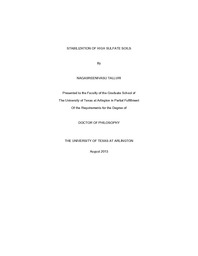
ATTENTION: The works hosted here are being migrated to a new repository that will consolidate resources, improve discoverability, and better show UTA's research impact on the global community. We will update authors as the migration progresses. Please see MavMatrix for more information.
Show simple item record
| dc.contributor.author | Talluri, Nagasreenivasu | en_US |
| dc.date.accessioned | 2013-10-22T23:59:40Z | |
| dc.date.available | 2013-10-22T23:59:40Z | |
| dc.date.issued | 2013-10-22 | |
| dc.date.submitted | January 2013 | en_US |
| dc.identifier.other | DISS-12312 | en_US |
| dc.identifier.uri | http://hdl.handle.net/10106/23923 | |
| dc.description.abstract | Stabilization of expansive soils using lime and cement has been a favorite technique for practitioners over the years. However, recent heaving and premature pavement failures in lime and cement treated subgrades containing sulfates led to question the validity of calcium based stabilization. When expansive soils containing sulfates are treated with calcium based stabilizers, calcium from stabilizer reacts with soil sulfate and clay alumina to form expansive mineral Ettringite. Formation and growth of the mineral Ettringite was reported as the cause of severe heaving in several pavement failures. Under favorable environmental conditions Ettringite transforms in to another expansive mineral Thaumasite. This heaving is termed as `sulfate induced heave' in literature. Several theories have been proposed to understand the heaving mechanisms in sulfate bearing soils. Based on the theoretical background researchers and practitioners have proposed various methods to treat sulfate soils. Applicability of these methods is questionable since most of these methods limit the sulfate content to 8,000 ppm. Soils with sulfate content above 8,000 ppm are termed as `high sulfate' soils and chemical treatment of such soils is to be avoided. Hence there exists a research need to create better understanding of heaving phenomenon in soils with higher sulfate contents and develop practical technique to stabilize such soils.This research is designed to understand heaving phenomenon in soils with sulfate contents above 8,000 ppm and develop practical techniques to stabilize such soils. Six soils: four high plasticity clays, one low plasticity clay and one high plasticity silt with sulfate contents varying from 200 ppm - 44,000 ppm were considered for this research. Chemical and mineralogical tests were performed on the untreated soils to establish the clay mineral distribution and composition of the soils. Additional Gypsum is added to the soils with sulfate contents below 8,000 ppm to be considered as `high sulfate'. These soils were treated with lime and mellowed for periods of zero, three and seven days. Following the mellowing, the samples were remixed, compacted and subjected to various engineering, mineralogical and chemical tests. Rate of Ettringite formation and growth in the treated soils were indirectly assessed from Bender Element tests. Two of the high sulfate soils were treated with combined lime and fly ash with mellowing and subjected to the engineering and chemical tests. Tests results were analyzed to understand heaving phenomenon in `high sulfate' soils.Both Ettringite formation and crystal growth have contributed significantly to the overall swell of the treated soils. Swell trends observed in the treated soils at respective mellowing periods were attributed to the variability in sulfate levels and reactive alumina and silica contents. It was observed that compaction void ratios and soil clay mineralogy have a significant impact on the swell behavior of chemically treated high sulfate soils. Bender Element tests revealed material softening and subsequent degradation in chemically treated high sulfate soils and threshold stiffness loss values were established for the treated soils. Mellowing effectiveness in treated soils is explained using free energy and mass-volume approaches. Swell prediction model based on sulfate contents was developed. Threshold void ratio frame work comprising of natural soil void ratio and sulfate content was developed to predict Ettringite induced heaving in chemically treated high sulfate soils at different mellowing periods. | en_US |
| dc.description.sponsorship | Puppala, Anand | en_US |
| dc.language.iso | en | en_US |
| dc.publisher | Civil & Environmental Engineering | en_US |
| dc.title | Stabilization Of High Sulfate Soils | en_US |
| dc.type | Ph.D. | en_US |
| dc.contributor.committeeChair | Puppala, Anand | en_US |
| dc.degree.department | Civil & Environmental Engineering | en_US |
| dc.degree.discipline | Civil & Environmental Engineering | en_US |
| dc.degree.grantor | University of Texas at Arlington | en_US |
| dc.degree.level | doctoral | en_US |
| dc.degree.name | Ph.D. | en_US |
Files in this item
- Name:
- Talluri_uta_2502D_12312.pdf
- Size:
- 5.755Mb
- Format:
- PDF
This item appears in the following Collection(s)
Show simple item record


